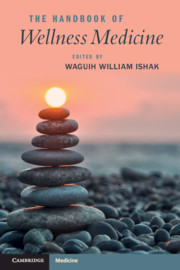Description
The Handbook of Wellness Medicine
Coordinator: IsHak Waguih William
This book presents scientific wellness interventions to aid healthcare professionals helping people complete their journeys to full health.
Language: English
Subject for The Handbook of Wellness Medicine:
Publication date: 08-2020
652 p. · 15.6x23.3 cm · Paperback
652 p. · 15.6x23.3 cm · Paperback
Description
/li>Contents
/li>Biography
/li>
Wellness medicine is the field that focuses on improving overall functioning, quality of life, and wellbeing, beyond symptom management of medical illness, leading to restoration and maintenance of health. The Handbook of Wellness Medicine provides a practical guide to the latest in evidence-based medicine, as well as best practice, to assist healthcare professionals in utilizing the full range of interventions to improve wellness and help patients complete their journeys to full health. The volume is organized into five parts: Part I introduces the concept of wellness by detailing the definitions and assessment/measurement methods, and formulating wellness plans. Part II describes wellness plans in major illnesses, categorized by organ system/disorder. Part III covers the methods to improve wellness in special populations. Part IV details each wellness intervention, including the scientific evidence behind it and its practical application. Part V focuses on integrating and personalizing the interventions into one's life to maintain wellness.
Part I. Approach to Wellness: 1. Defining wellness; 2. Screening and assessment methods; 3. The biopsychosocial assessment; 4. Wellness measurement; 5. The wellness treatment plan; Part II. From Illness to Wellness by Organ Systems/Disorders: 6. The concept of wellness in psychiatric and substance use disorders; 7. Neurological and neurosurgical disorders and wellness; 8. Cardiovascular and pulmonary wellness; 9. Gastrointestinal system and wellness; 10. Wellness and the genito-urinary system; 11. Reproductive system, pregnancy, and post-partum wellness; 12. Allergic, infectious, immunological system; 13. Wellness in endocrinal and metabolic disorders; Part III. Special Populations and Special Topics: 14. Wellness in patients living with chronic medical conditions; 15. Wellness in older individuals; 16. Child and adolescent wellness; 17. Wellness in pain disorders; 18. Wellness in cancer and neoplastic diseases; 19. Wellness in terminal illness; 20. Wellness interventions in the workplace; 21. Wellness interventions for physicians and health care professionals; Part IV: Wellness Interventions: 22. Nutrition; 23: Nutraceuticals and wellness; 24. Pharmaceuticals and alternatives for wellness; 25. Exercise, dance, tai-chi, Pilates, and Alexander technique; 26. Sleep, rest, and relaxation; 27. Sex, intimacy, and wellbeing; 28. Mindfulness, meditation and yoga; 29. Gratitude, forgiveness, and spirituality; 30. Positive neuropsychology, cognitive rehabilitation, and neuroenhancement; 31. Acupuncture, herbs, and Ayurvedic medicine; 32. The role of aesthetics in wellness; 33. Massage, humor, and music; 34. Nature, and pets; 35. Circadian rhythm in the digital age; 36. The arts in health settings: inspirational, educational and therapeutic approaches to wellness; 37. Engaging the five senses: taste, smell, see, listen, and touch; 38. Emotional intelligence and its role in sustaining fulfillment in life; 39. Psychotherapy and positive psychology; 40. Resilience and wellness; 41. Developing purpose, meaning, and achievements; 42. Healing and wellness; 43. Connection, compassion and community; 44. Wellness interventions for chronicity and disability; Part V. Wellness through Optimization of Work, Love, and Play: 45. Work, love, and play and the joy of living (Joie de Vivre); 46. Work and life balance; 47. Family relations, friendships, and love; 48. The role of leisure, recreation and play in health and well-being; 49. Wellness and whole person care; 50. The personalized wellness life plan; Appendix I. Wellness measures; Appendix II. Wellness apps and devices.
Waguih William IsHak, MD, FAPA is Professor and Clinical Chief of Psychiatry at Cedars-Sinai Medical Center, and Clinical Professor of Psychiatry at the David Geffen School of Medicine at UCLA. IsHak has over 30 years of experience in psychiatry, psychotherapy, and psychopharmacology, with specific expertise in quality of life, ways to restore and maintain health, and removing behavioral barriers to wellness. His articles have appeared in JAMA Psychiatry, Harvard Review of Psychiatry, and Quality of Life Research. Dr IsHak served as Chief Proctor and Examiner for the American Board of Psychiatry and Neurology, and he is a Distinguished Fellow of the American Psychiatric Association.
© 2024 LAVOISIER S.A.S.

